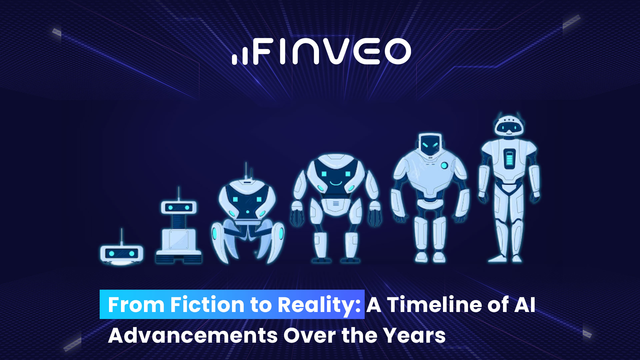Artificial Intelligence, or AI, has been a topic of fascination for decades. What was once considered a concept only found in science fiction books and movies, has now become a reality. The advancements in AI technology have been nothing short of impressive and have revolutionized the way we live, work and communicate.
In this article, we will take a trip down memory lane and explore the timeline of AI advancements over the years. We will delve into the breakthroughs that have paved the way for the technology we see today and the exciting possibilities that lie ahead. So, get ready to discover the incredible journey of AI, from fiction to reality.
The 1950s - The birth of AI
The idea of AI was first introduced in the 1950s when computer scientist John McCarthy coined the term "artificial intelligence" at the Dartmouth Conference. It was during this time that the first AI programs were written, such as the Logic Theorist and the General Problem Solver.
The 1960s - Early developments
In the 1960s, AI research focused on developing rule-based systems and natural language processing. The first chatbot, ELIZA, was created during this time, which simulated a conversation with a psychotherapist.
Machine Learning emerged as a field of study that aimed to develop algorithms that could learn from data. The field was pioneered by Arthur Samuel, who developed a computer program that could play checkers at an expert level.
The program was designed to learn from its mistakes and improve its performance over time. This concept of machine learning paved the way for the development of more advanced AI systems that could learn from data and improve their performance.
The 1970s - Knowledge-based systems
In the 1970s, AI research shifted towards developing knowledge-based systems. These systems used expert knowledge to solve complex problems. This was also the time when the first autonomous vehicles were developed, such as the Stanford Cart.
The 1980s - Expert systems
The 1980s saw the development of expert systems, which were designed to provide expert advice and decision-making. These systems were widely used in fields such as medicine and finance to predict stock prices.
The 1990s - Machine learning
The 1990s saw the emergence of machine learning, which allowed computers to learn from data and improve their performance over time. This was also the time when the first search engines were developed, such as Yahoo and AltaVista.
The 2000s - Big data and deep learning
The 2000s saw the advent of Deep Learning, which is a subset of Machine Learning that uses artificial neural networks with multiple layers. The technology allowed machines to learn from vast amounts of data and make more accurate predictions.
One of the most significant breakthroughs in Deep Learning came in 2012 when Alex Krizhevsky developed AlexNet, a Deep Learning algorithm that won the ImageNet Large Scale Visual Recognition Challenge. Technology revolutionized the field of image recognition and paved the way for developing more advanced AI systems.
The 2010s - AI becomes mainstream
The 2010s saw AI become mainstream, with the development of self-driving cars, facial recognition systems, and chatbots. This was also the time when deep learning algorithms such as neural networks became more prevalent, as well as the period when Siri and Alexa were invented.
One of the most significant breakthroughs in Reinforcement Learning came in 2013 when DeepMind developed a system that could learn to play Atari games at a superhuman level. The technology paved the way for the development of more advanced AI systems that can learn complex tasks and make decisions in real-time.
In 2014 Tesla motors announced its first version of autopilot. The cars equipped with this AI development system could control lanes with autonomous steering, braking, and speed limit adjustment based on signal image recognition.
At the very end of the decade, in 2019, Google researchers worked with Northwestern Medicine to build an AI system that detects lung cancer more accurately than humans.
2020s - AI and the future
In the 2020s, AI is set to become even more advanced, with the development of quantum computing and advanced robotics. AI is also expected to play a critical role in fields such as healthcare, transportation, and education.
One of the most notable advancements has been in the field of natural language processing, which has allowed machines to understand and interpret human language.
The technology has been used to develop chatbots, virtual assistants, and speech recognition systems. Another significant advancement has been in the field of computer vision, which has allowed machines to recognize and interpret visual data.
AI technology has been used in self-driving cars, security systems, and facial recognition systems. It has also made significant advancements in the field of robotics, where machines are being developed that can perform complex tasks and interact with humans.
At the end of 2022, in November, the Chat GPT has been released as a breakthrough in the AI era and made easy access to everyone. This OpenAI model gave access to endless possibilities for creating unique content, and many people tested its capabilities of even creating songs, poems, and other artistic forms, while some used it for generating codes.
The future of AI holds endless possibilities and will continue to revolutionize the way we live, work, and communicate. Some of the areas where AI is expected to make significant advancements in the future include:

Autonomous vehicles

Advanced robotics

Predictive analytics

Personalized medicine

Augmented reality
AI is also expected to create new job opportunities and transform the way we work. As machines become more intelligent, they will be able to perform tasks that were once only possible for humans. As AI is now evolving at a rapid pace, it brings some challenges and might cause some ethical concerns, but it’s up to time to see in which direction it will develop.
Final Thoughts
In conclusion, AI has come a long way since its inception in the 1950s. With each passing decade, technology has become more advanced, and today it is an integral part of many aspects of modern life. As we move into the future, AI is set to play an even more significant role, transforming the way we live and work. The possibilities are endless, and the future of AI is exciting. As we continue to develop more advanced AI systems, we can only imagine what the future holds.



















